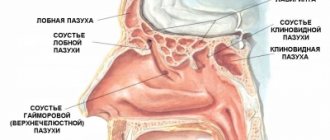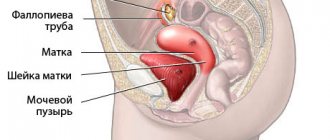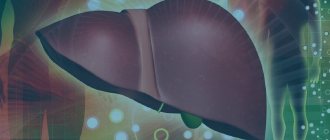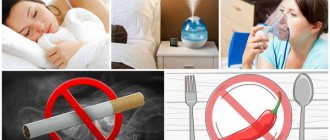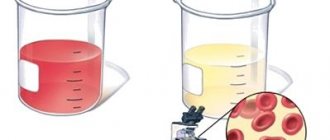There are two main forms of salpingoophoritis:
- acute form of salpingoophoritis;
- chronic form of salpingoophoritis.
Acute salpingoophoritis
Clinical signs of acute salpingoophoritis can be expressed more or less significantly, depending on the severity of the inflammatory reaction and the extent of the process.
Characterized by:
- deterioration of general condition (weakness, general malaise, headache, chills, tachycardia, etc.);
- increased body temperature, sometimes to high levels;
- constant pain in the lower abdomen, which can become severe. Pain can radiate to the lumbar region, rectum, lower extremities;
- possible dysuric disorders;
- changes in blood tests (increased leukocytes, ESR, etc.)
The causes that cause acute salpingoophoritis may be:
- an infection that enters a woman’s genitals during sexual intercourse;
- previously untreated diseases of the genital organs (vulvitis, vaginitis of various etiologies), leading to the spread of foci of infection to the appendages;
- abortions;
- surgical interventions (insertion or removal of an IUD, RDV, etc.);
- chronic stressful situations;
- low standard of living.
Diagnosis of acute salpingoophoritis
Diagnosis of acute salpingoophoritis is based on:
- gynecological examination (it is necessary to consult a gynecologist in time);
- collecting anamnesis (history of the disease);
- clinical picture of the disease (assessed by a gynecologist);
- laboratory data (smears from the vagina, cervix, cervical canal - smears for flora, PCR, culture tank, blood tests, urine tests);
- ultrasound examination of the pelvic organs.
Treatment of acute salpingoophoritis
Every woman should understand that timely initiation of adequate therapy will help to avoid a lot of health problems in the future!
Treatment in the acute stage is carried out only in a hospital setting. The main place is occupied by antibacterial therapy (in the acute stage, intravenous antibiotics are often used), the effectiveness of which is determined by the properties of the pathogen and its sensitivity to a particular antibiotic. Treatment of acute salpingoophoritis is always determined by the doctor depending on the general condition of the woman and the extent of the inflammatory process.
With timely treatment, acute inflammation of the appendages can result in complete recovery. In case of untimely treatment, it can become a chronic process that lasts a long time (months, years).
Chronic salpingoophoritis
It is characterized by the presence of infiltrates, loss of physiological function of the mucous and muscular membranes of the tubes, development of connective tissue, sclerotic processes, which often lead to obstruction of the fallopian tubes with or without the formation of hydrosalpinxes (adhesions in the tubes). Adhesions may form near the tubes in the abdominal cavity, which prevent the egg from being captured.
Clinic of chronic salpingoophoritis
The clinical picture of chronic salpingoophoritis is varied:
- pain in the lower abdomen (dull, aching, periodically intensifying, with provoking factors: stress, hypothermia, previous acute respiratory viral infections, etc.);
- menstrual dysfunction;
- painful sensations during sexual intercourse;
- increased discharge from the genital tract;
- primary or secondary infertility;
- spontaneous miscarriages, premature births;
- intrauterine infection of the fetus during pregnancy;
- There is often a disruption in the functioning of the digestive organs (gastroenterocolitis) and the urinary system (cystitis);
- with a long course of chronic salpingo-oophoritis and frequent relapses, disruption of the nervous, endocrine and other body systems is possible, leading to a decrease in working capacity.
With exacerbations of chronic salpingoophoritis, all of the above symptoms of acute salpingoophoritis are noted.
Diagnosis of chronic salpingoophoritis
Diagnosis of chronic salpingoophoritis is also based on:
- collecting anamnesis (history of the disease);
- gynecological examination;
- clinical picture of the disease;
- laboratory research;
- ultrasound data, MRI if necessary;
- endoscopic research methods (hysteroscopy, laparoscopy);
- hysterosalpingography.
Particular attention should be paid to hysterosalpingographic examination of the fallopian tubes.
GHA is recommended for initial assessment of the condition of the pelvic organs in chronic salpingoophoritis and long-term infertility. The fallopian tubes occupy a unique position in a woman’s body, performing the complex function of conducting sperm (from the uterus to the abdominal cavity and vice versa). The patency and functioning of the fallopian tubes are critical for conception. HSG is an intrauterine injection of a substance with further x-ray examination of the pelvis, which gives a 100% possibility of assessing the patency or obstruction of the fallopian tubes. The procedure is widely used in outpatient settings.
Treatment of chronic salpingoophoritis
Treatment includes various methods of drug and non-drug therapy, taking into account clinical manifestations, additional research methods and laboratory data.
During the period of exacerbation of chronic salpingoophoritis, hospitalization in a hospital is possible, depending on the woman’s condition and the prevalence of the inflammatory process. An important principle in the treatment of chronic salpingoophoritis is a combination of medications and local treatment (in particular physiotherapy).
Another method of treating chronic salpingoophoritis, especially with the aim of restoring fertility (tubal patency), is a surgical method (laparoscopy). During laparoscopy, the doctor clearly assesses the condition of the fallopian tubes, ovaries, pelvic peritoneum, the presence or absence of adhesions in the pelvis, the presence or absence of pathological foci. With the laparoscopic method of treatment, dissection and coagulation of adhesions, release of the fimbrial sections of the fallopian tubes, ovaries and other types of manipulations are performed.
The success of treatment of women with salpigo-oophoritis is determined by timely and rational management tactics, timely initiation of therapy, and correctly chosen surgical treatment.
At the Scandinavian Health Center, highly qualified and experienced obstetricians and gynecologists provide comprehensive diagnosis and treatment of salpigo-oophoritis.
Bilateral salpingoophoritis
Bilateral salpingo-oophoritis (adnexitis) is characterized by an inflammatory process involving both appendages at the same time.
The disease has three main stages of development. Acute stage. It is characterized by the appearance of dull, aching, sometimes sharp, pronounced pain in the lower abdomen, which intensifies more often 7 days before the start of the menstrual cycle and continues in some cases during it. Subacute stage. This stage is considered non-specific due to the fact that it does not have a clear clinical picture. In some cases, during the subacute stage of the disease, the following may be present:
- general weakness;
- problems with urination;
- menstrual irregularities;
- itching in the perineum and genital area;
- bloating and tenderness in the lower abdomen.
The subacute stage is transitional and has a short time period, and therefore patients do not always notice the presence of a problem, mistaking adnexitis for ARVI or a cold. As a result of the lack of timely treatment, the disease progresses to the next stage. Chronic course. The chronic course of salpingoophoritis is characterized by temporary asymptomaticity, creating a feeling of recovery. Symptoms of the disease appear only during acute relapses.
Salpingitis - symptoms and treatment
Treatment of acute salpingitis
Treatment of an acute process should be carried out in a hospital setting, where physical and mental rest is created, control of excretory function (accounting for the daily volume of urine excreted and control of stool regularity).
The main role in treatment is given to antibacterial drugs that are sensitive to the pathogen. It is recommended to use broad-spectrum drugs or combinations of antibacterial drugs, taking into account the antibiogram (determining the sensitivity of pathogenic microflora to antimicrobial drugs). Combinations of drugs are selected according to the principle of “bactericidal drug with bactericidal”, “bacteriostatic with bacteriostatic”. It is necessary to comply with the dosage regimen and duration of therapy (at least 7-10 days). For severe symptoms of intoxication (increased body temperature above 38 °C, chills, weakness, dizziness, nausea, vomiting), adequate infusion-transfusion therapy (ITT) is used, which involves the introduction of various solutions into the body, often intravenously. They also compensate for protein losses, improve the rheological (flowing) properties of blood and microcirculation.
In case of severe intoxication, ITT is carried out in a volume of 1500-2000 ml/day daily for the first 3 days, then every other day for 7-10 days.
With an average degree of intoxication, the volume of infusion-transfusion therapy is reduced to 500-1000 ml/day. If necessary, add vitamins and drugs that correct the acid-base state. Pathogenetically significant is the prescription of non-steroidal anti-inflammatory drugs (NSAIDs). They work as follows:
- limit exudative manifestations of the inflammatory process;
- reduce the activity of inflammatory mediators;
- have an analgesic effect;
- prevent thrombosis;
- weaken the body's increased sensitivity (desensitizing effect);
- have an antipyritic (antipyretic) effect.
The use of antihistamines (eliminate the symptoms of an allergic reaction), sedatives and desensitizing agents, drugs that improve metabolic processes in cells and tissues involved in fat, protein, and carbohydrate metabolism is indicated.
Surgical laparoscopy provides the possibility of effective therapy. The technique is the same as for diagnostic laparoscopy, but in addition to the laparoscope, trocars are inserted into the abdominal cavity through additional punctures - hollow tubes through which instruments (special knives, clamps, needles with suture material, etc.) get inside.
Depending on the pathology detected during surgical laparoscopy, various therapeutic measures are carried out:
- irrigation of the fallopian tubes with an isotonic solution containing an antibiotic or antiseptic;
- separation of tender fresh adhesions, release of the fimbryonic part of the tubes and ovaries from the adhesions;
- aspiration of pus (removal of pus with a syringe and needle) if present;
- drainage (incision with release of fluid) of the pyosalpinx, emptying of the abscess of the utero-rectal space and other localization.
Often this method helps restore reproductive function. The most effective method in the presence of a purulent process in the appendages is their removal. In the subacute stage, autohemotherapy (transfusion of one’s own blood), physical treatment: UV irradiation, medicinal electrophoresis, vibration massage, ultra-high frequency therapy (UHF therapy) are recommended [4][9][10][11][12][13].
Treatment of chronic salpingitis
Treatment of a chronic process is aimed at analgesic and anti-inflammatory effects, increasing the body's defenses, restoring sexual functions, disorders of the nervous, endocrine and other body systems.
There is a classification of degrees of cure used in practice:
- Level 1 - clinical recovery. Improvement in general condition: disappearance of pain and anatomical disorders characteristic of exacerbation; elimination of inflammatory changes in blood tests.
- Level 2 - normalization of the endocrine function of the reproductive system (restoration of menstrual function).
- Level 3 - restoration of adaptive and protective mechanisms, correction of homeostasis disorders and rehabilitation of reproductive function.
At the first level, treatment includes the use of antibacterial agents, which is indicated in the following cases:
- during exacerbation of the inflammatory process;
- if during treatment during the acute period antibiotics were prescribed without taking into account the antibiogram;
- if there is inflammation in the vagina and/or cervix;
- during invasive interventions on the pelvic organs in patients with chronic inflammation of the appendages.
The second and third stages require long-term treatment and continue under the supervision of a local gynecologist in the gastrointestinal tract after hospital treatment [6][13].
Surgical treatment to restore fertility (the ability to reproduce): dissection of adhesions, release of the fimbrial sections of the tubes, ovaries, removal of exudate.
Physiotherapy also plays an important role in the treatment of chronic salpingitis and should be used more widely than in the acute and subacute phase. Ultrasound is used, which has a fibrinolytic and analgesic effect. Electrophoresis on the area of the appendages with anti-inflammatory drugs. High-frequency magnetic therapy of the appendages, normobaric hypoxic therapy, ultraphonophoresis, acupuncture, carbon dioxide and radon gynecological irrigation. Spa treatment in mud baths, balneotherapy.
In order to normalize the endocrine function of the reproductive system, combined estrogen-gestagen drugs are prescribed according to the contraceptive regimen.
Psychotherapy comes down to explaining the essence of the pathological process and creating in patients a correct idea of their state of health [6].
Consequences and complications of salpingoophoritis
Lack of timely qualified treatment of adnexitis can lead to quite serious complications:
- infertility. It may develop against the background of a violation of the ovulatory function of the ovaries resulting from the inflammatory process;
- adhesive process. The formation of adhesions leads to obstruction of the fallopian tubes, which in turn can be complicated by both the development of an ectopic pregnancy and complete infertility.
In addition to the listed complications, chronic salpingoophoritis can lead to:
- menstrual irregularities;
- development of infectious and inflammatory processes in the genitourinary system;
- decreased libido;
- development of pelvioperitonitis.
This disease is also extremely dangerous during pregnancy, as it can lead to:
- premature labor;
- termination of pregnancy (miscarriage);
- intrauterine growth retardation;
- infection of the membranes and the fetus itself;
- early placental abruption;
- endometritis.
Signs of chronic salpingitis
At chronic salpingitis, the general condition of the woman is satisfactory, normal body temperature, pain in the lower abdomen is persistent, but not very pronounced. The examination reveals a thickened, painful fallopian tube with limited mobility. Chr. Salpingitis occurs with exacerbations, which are provoked by various factors - overwork, hypothermia, concomitant infections, stress.
There are two options for exacerbations of salpingitis. In one case, an exacerbation is associated with an increase in the pathogenic properties of the same pathogens or the presence of another (secondary) infection. In this case, discharge from the genital tract, significant pain in the area of the uterine appendages during examination, and low-grade fever are observed. In the second variant of exacerbation of chronic In case of salpingitis, the symptoms of a violation of the woman’s general condition come to the fore: prolonged deterioration in health, weakness, increased irritability, and the role of the microbial factor is minimal. The examination reveals dense, moderately painful, enlarged uterine appendages. Chr. salpingitis can also be left-sided or right-sided.
Prevention of salpingoophoritis
The main points for the prevention of salpingoophoritis are:
- use of contraceptives only on the recommendation of a doctor, taking into account all the rules and nuances of their use;
- refusal of unprotected sex;
- refusal of abortion;
- avoiding hypothermia;
- refusal to wear tight underwear and underwear made from synthetic fabrics;
- maintaining personal hygiene without abuse of low-quality cosmetics or physiologically incorrect Ph indicators;
- timely visit to the doctor both for preventive examination and for treatment of diseases.
2. Reasons
The direct cause of inflammation of the uterine appendages is the ascending (from the vagina and uterus) or descending (from other foci, with the blood and/or lymph flow) spread of a bacterial infection. Almost any pathogenic microorganism can act as a pathogen: all kinds of cocci, bacilli, tuberculous mycobacteria, etc. Often this kind of infection is transmitted from a partner during sexual intercourse; in other cases, the source becomes chronic tonsillitis, sinusitis, untreated infections in the oral cavity, etc.
Direct risk factors for the occurrence (or exacerbation) of salpingoophoritis include:
- abortions;
- unhealthy lifestyle, including the prevalence of overload and situations of chronic psycho-emotional stress;
- sexual excesses, promiscuity and other experiments;
- intense hypothermia, especially in the legs, pelvis, and lower back;
- unbalanced and inadequate diet;
- general exhaustion and immune deficiency (for example, during the rehabilitation period after large-scale abdominal surgery);
- failure to comply with the simplest rules of genital hygiene.
Visit our Gynecology page
A few words about tuberculous salpingitis
With tuberculous salpingitis, there must be a primary focus in the lungs, intrathoracic, intra-abdominal lymph nodes or bone tissue. Tuberculous salpingitis in most cases is chronic, and acute phenomena are observed only with a caseous process. The most common symptoms of tuberculous salpingitis are bloody discharge from the genital tract, pain in the lower abdomen, and severe pain during menstruation. When examined, most women exhibit enlarged appendages. The diagnosis is made on the basis of a biopsy - tuberculous granulomas are found in the endometrium.
